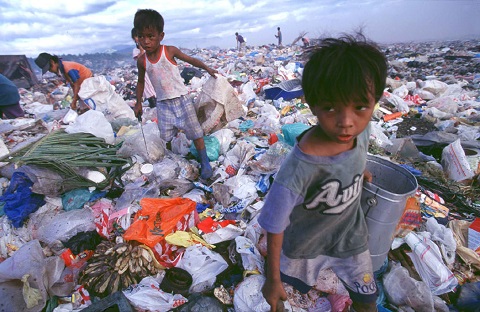Now I know you’re probably wondering why our country, which is already facing issues left and right, should help the capital city of Norway with its rather peculiar concern. Believe it or not folks, it’s a win-win solution for both countries and one that can ultimately help in solving our issues with flooding here in the metro.
Oslo’s problem: the city is running out of garbage. That’s right, the city of 1.4 million is facing shortage of wastes. In fact, they’ve been faced with this issue in the past and have even resorted to importing garbage from neighboring cities and countries. But it was still not enough and there have been talks of bringing in trash from the US.

So why is the city running out of trash? Besides the fact that they implement a highly-efficient garbage collection system, the city also owns a trash incinerator that turns crap to usable energy. Since its conception, the facility has been one of the sources of electricity in the city and it helped in minimizing wastes that is being put to landfills.
But the problem here is that the city is not generating enough garbage (what a problem ‘eh?) to sustain the facility, that’s why the city had to import trash from other cities and countries. On the other hand, we have so much crap that we don’t know where to put all of it. Heck, even our rivers are filled with garbage, that’s how much garbage we have lying around.

Which brings me to my suggestion; why don’t our country donate our garbage to Oslo? Or better yet, why don’t we build our own facility so we don’t even have to export our waste half –way around the world to get of rid of it and turn it to something useful.
Sounds like a good plan, right? However, the Secretary of DENR, Mr. Ramon Jesus Paje has a different take on this matter which he mentioned during an interview with ANC a couple of years back:
“If we allow incineration of our waste, we must avail of state-of-the-art technology, almost zero emission. The only problem is the Philippines is one of the highest in terms of electricity cost and incineration is basically electricity. If power [cost] is so high, it becomes uneconomical.”
Oh well, back to the drawing board.
{source} {via} {Image Credit}
































May advance nang technology ngayon sa incineration na hindi delikado ang usok sa environment, pero hindi matuloy tuloy dahil sa mga pulitikong ayaw makipag-cooperate, kung gusto daw matuloy, dapat kikita din daw sila dyan hehe.. you know what i mean..
Shipping of Garbage??? Common, you have no idea how COSTLY it is to charter ships! for single journey, charterer spends millions of $$$ for valuable cargo. But for Garbage? Trust me, it’s impossible. Unless, the Norwegian government shoulder all the fees! :)
oh only if it is as easy as transporting garbage between Sim cities. I’ve always dreamed of incinerating facilities since I was a child playing Sim City :)
Let’s see na lang di lang overcrowded sa basura ang Pinas overpopulated di sa polusyon.
pyrolisis is a relatively new tech from japan that turns almost anything into fuel, electricity and charcoal powder. a small machine, manufactured by korea, will cost around 10 million u.s. dollars and can convert about 20 tons of garbage everyday. the only electricity needed to run it is to power it up, afterwhich it becomes self-running. it also passes all emission tests from most european countries.
That new technology should be looked into by everyone else- if the government cant finance it then why not included it in the ppp lined up projects-
Sa tingin ko hindi din nila tatanggapin ang basura natin. Ang basura na ginagamit nila ay naka waste segregation na. Isa pa sobra sobra ang basura natin. Ang populasyon natin sa Metro Manila pa lang ay mahigit sa 1,000% mas madami sa populasyon nila. Ang kelangan natin talaga ay disiplina ng mga nakatatanda at edukasyon sa mga nakababata para maturuan nila mga magulang nila na matitigas ang ulo.
My 2 cents worth:
We cannot afford to build a similar highly-efficient garbage collection system as what Oslo has. That probably will cost billions of pesos to build, operate and maintain. Unless the cost of this technology goes down, it’s just not feasible for our country.
I get what Mr. Paje was trying to say. Yes, the facility is supposed to generate electricity, but generally, what he’s trying to say is that for every P100 cost of power the plant uses to ‘burn’ garbage, it will only generate P50 worth of power. Hence, it becomes uneconomical (note, these figures are merely examples).
So do we transport the garbage? Possible. But the distance from PH to Oslo is 9,826.73kms…. and that’s the straight line distance. I’m estimating the nautical route to be around 15,000kms via the South Atlantic. It’s going to be very costly for us to ship our trash there given these distances.
I think ultimately, the best (and easiest) solution is for Oslo to bring their ships here, we load them up with our garbage, then we pay them a fraction of their (Oslo’s) cost. After all, they’re going to be making money out of our garbage, anyway, after it’s converted to power. Also, I’m pretty sure we have government budget allocation for garbage disposal… what I’m not sure about is if the allocation still exists, or if it’s already been pocketed.
Why doesn’t Mr. Paje consider the benefits instead of just the cost of building incinerators? I read in the news the other day that P1.5T is wasted over 10 years due to traffic jams. This cost involves only fuel cost and wasted manhours. If we can reduce the garbage that causes flood then maybe loss of lives and damage to properties due to floods will also be reduced. Maybe the electricity produced by these incinerator can also reduce the cost of electricity in Metro Manila, which can also attract investors.
Ironically, we cannot build incinerators in Philippines due to Republic Act 8749 or the Clean Air Act of 1999 which bans them.
Naga City will soon have a facility that will turn trash into garbage. it is now under construction. Read this news from inquirer:
Although it has never been tried anywhere in the country, Naga City is optimistic that a P3-billion project on a five-hectare government property can convert garbage into electric energy while solving its waste problem.
The facility in Barangay San Isidro could generate eight megawatts of electricity from 100 tons of trash fed into it daily and collected from the city’s 27 villages, according to Oscar P. Orozco, head of the Naga City Environment and Natural Resources Office.
With Naga taking in more settlers and attracting more businesses, Orozco said the present Balatas open dump could no longer hold the volume of garbage in five years. “The 20-25 percent of trash segregated cannot reduce the pile of garbage mounting every day,” he said in a phone interview.
Joint venture
A South Korean company, CJ Global Green Energy, and a Japanese company, Hitachi Zosen, are expected to build the energy plant in two years after the ground-breaking ceremony held on Nov. 22 last year. Among those who attended the program were Energy Secretary Carlos Jericho Petilla and Environment Secretary Ramon Paje.
Mayor John Bongat said the pioneering effort could be replicated in other areas.
The city government and the Department of Environment and Natural Resources (DENR) signed a joint venture agreement for the project on Aug. 24, 2010. After an environmental review showed the project to be viable, the process to be used in the facility was approved the following month. On Oct. 20, 2011, the project was granted an environmental clearance certificate.
According to the DENR, the San Isidro site, which is more than 250 meters away from residential areas and other urban infrastructures, passed the international criteria set for such plants and sanitary landfill.
Orozco said the facility would use “gassification” or the process of converting solid wastes into gases without combustion. A machine pulverizes the trash and stirs in it a very hot solvent, from which steam is generated, causing a turbine to produce electricity.
When the steam condenses, the liquid is collected and diverted to the first chamber to serve as solvent for the next batches of trash in order to start another cycle.
“For every 100 tons of garbage, some eight megawatts of electricity will be produced. CJ Global is aiming to produce 20 megawatts for each cycle,” Orozco said.
He gave assurance that no fumes or residue would be produced to harm the surroundings because no chemical is used to break up complex substances and convert them into hydrogen and oxygen.
The plant will be established in accordance with Republic Act No. 9003, also known as the Ecological Solid Waste Management Program, which encourages the establishment of such facilities and prohibits dumps.
Distribution to consumers
Once the facility is operational, CJ Global will offer electricity to the National Grid Corp. of the Philippines (NGCP) or the Camarines Sur II Electric Cooperative (Casureco II) for distribution to consumers.
“If negotiations with NGCP or Casureco II fail, the city will assume the task of distributing and selling electric power to consumers,” Orozco said.
The operation of the waste-to-energy plant will also bring cash to the city government if neighboring towns would opt to dump their garbage in a complementary landfill.
“The city will encourage nearby municipalities to dump their garbage into the adjoining sanitary landfill for a tipping fee of P200 per ton, a tad cheaper than keeping a dumpsite that costs P45 million per year,” Orozco said.
Read more: http://newsinfo.inquirer.net/341741/p3-b-facility-to-turn-naga-trash-into-energy#ixzz2WwlXFTFq
Follow us: @inquirerdotnet on Twitter | inquirerdotnet on Facebook
you only get the benefits of incinerators if they are properly designed and built and that’s what Oslo have achieve.. instead of sending the trash to Oslo why now put up the very same incinerator where that Oslo have so we at least get the same benefits. problema sa pilipino panay reklamo agad… this was proposed years ago pero ang dami na namang epal na humaharang sa proposal… God bless Philippines
isa sa humaharang dyan ay mga makakalikasan, and Institute of integrated electrical engineers promotes green energy, kung icoconvert ntn ang basura sa energy para naring tayung gumamit ng coal oh fuel para makagenerate ng electricity ,na makakalason sa kalikasan,, mdameng sector, ang iniisip lang nila kung anu ang pinglalaban nila, hindi yung kung anong maitutulong nito sa bansa..
^_^
With Filipinos penchant of throwing things and recycling is the last thing in our mind, a system like this, no matter how expensive the machine is, will be beneficial for everybody.
No more floods, clean esteros and no more “smokey mountain” in the making.
Stupid Greenpeace wouldn’t allow it. Kahit na 0% emission pa yan kokontrahin nila yan dahil papansin sila. Bawal daw kasi ang incineration sa clean air act, but that’s an old law based on old data, it needs to be ammended para makasabay sa makabagong technology.
There are a lot of waste to energy solutions, wala lang talagang initiative ang gobyerno. Pwede pa nga ibenta yang basura sa mga companies na gumagamit ng coal or fuel para sa production nila. Wala lang talagang kumikilos ng tama.
for now, the very good idea is to transport our garbage given that Norway must provide their sea carriers to pick-up our garbage. but I don’t think they will prioritize our country because the Philippines is too far from them. if only the nearby Japan, Taiwan, Singapore, Hongkong or Malaysia had the facility and faces the same dilemma. with this technology, I see a brighter Philippines because we had lots of waste here. hope we could have this or better than this in the future.
Kaya nde matutupad yan ganyang solusyon sa Pinas ay dahil sa mga Corrupt na pulitiko!
Proper waste disposal + disciplined society is the long term solution to our garbage problem. I know its easier said than to be done. I commonly see people throwing small trash like candy wrappers and upos ng yosi everywhere.
I don’t think that we should avail “state of the art” technology for that kaagad. I know our engineers and local inventors can build one. Kulang lang sa R&D budget.
I think, building this needs a massive place to build it in. Plus, the fact that we still have a lot of liabilities to pay, constructing this project would be costly. But I agree, that we should transport our trash to Oslo. But first, we have to have an agreement. That if exporting trash to Norway, would be costly then, they should help us find a way to Export them to Oslo
“Since its conception, the facility has been one of the sources of electricity in the city…”
“The only problem is the Philippines is one of the highest in terms of electricity cost and incineration is basically electricity. If power [cost] is so high, it becomes uneconomical”
Is Paje confused on how the facility works????
this is a stupid proposition IMO. tell us the steps on how to consumate your idea then? one word: transport!
But isn’t that the point of using an incinerator, to generate electricity or does it not power itself?
Am I missing something here?
uh oh, you’re referring to “generator”? incinerator is to incinerate, to burn or to dispose into ashes… and it consumes electricity.
“the city also owns a trash incinerator that turns crap to usable energy. ”
@red, yeah but after it incinerates the trash it turns it into electricity, so I think it should be able to sustain itself.
Honestly why can’t our government do something like this or should I go for another ‘monopoly conspiracy theory’ :)
@westbluef: yeah you’re right. our country had lots of potentials with its bright minded children, however many of them use their extraordinary ability to cheat people and protect their self-interest. anyway I can’t comment with what the DENR Sec had said, I have no idea how profitable the technology is.. but having that incinerator is a very good idea indeed!
So what you’re trying to say is we ship our garbage to Oslo which is 9xxx kilometers from Manila? Seems legit. LOL!
Method 2 is more viable, maybe we should hire Norwegian engineers to help us. ;)
“Oslo has big a problem and PH should consider helping” Naguluhan ako sa title ng post.
nagkabaliktad lang pala ang “a” at “big” ng position.
This is where the Bataan Nuclear Power Plant comes into play